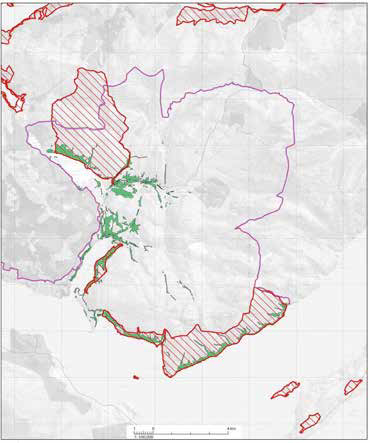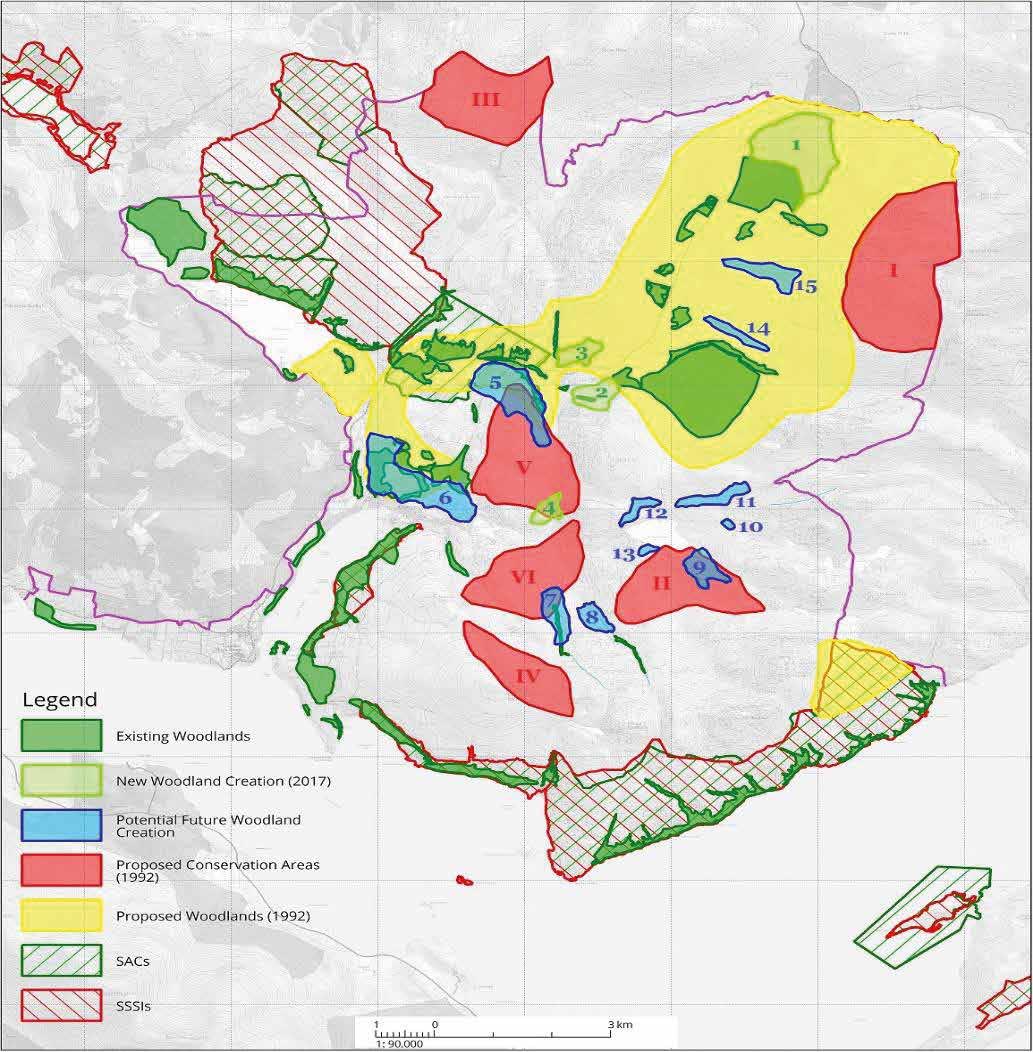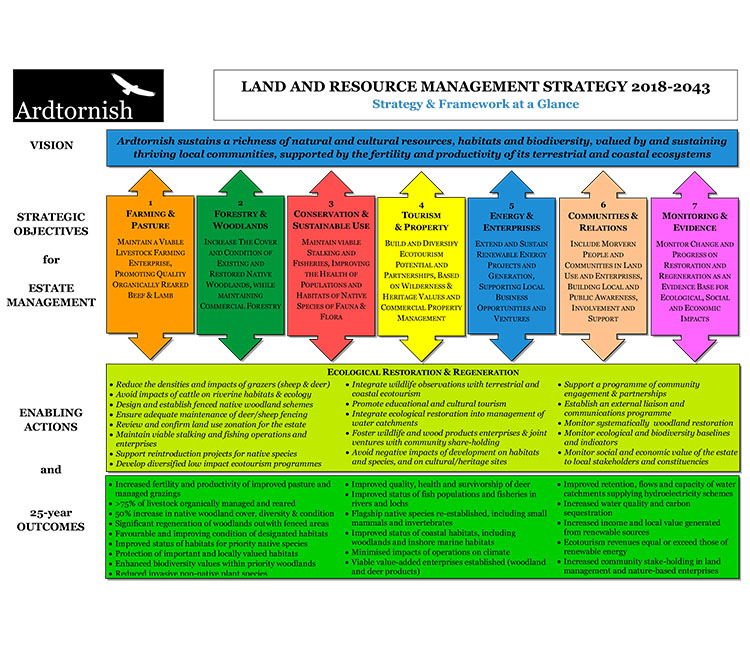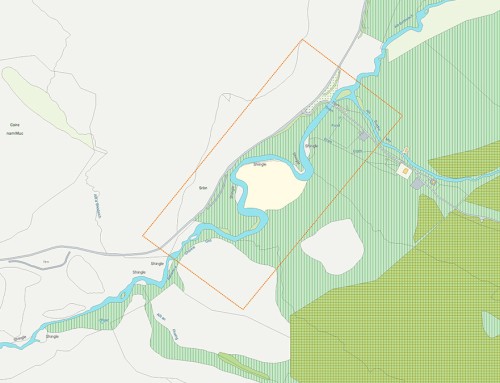25 years from 2018 – incorporating ecological restoration
This consultation document – which we hope will circulate widely – is intended to gather opinions about plans to change land use at Ardtornish. It proposes, over a long period – perhaps fifty years or more – to restore a more natural landscape. And it suggests how Ardtornish could support a wider range of enterprises and wildlife. It’s drawn from a much longer paper commissioned by Ardtornish that we intend to publish in due course.
If you are able to find time to read it and let us know your comments, we would be delighted to hear them.
To respond, please contact Tony McInnes on 01967 421288, at Ardtornish, Morvern, Oban, Argyll, PA80 5UZ,
or by e-mail at consultation@ardtornish.co.uk
Thank you
Tony McInnes (chief executive)
Susan Hitch (board member)
Dennis Overton (chair of the board)
Hugh Raven (family director).
The owners, the Raven Family, in addition to creating local employment and supporting a thriving local community, would like to see more nature and wildlife at Ardtornish. Their Statement of Purpose for the business is as follows:
Ardtornish covers about a fifth of the 650 km2 Morvern peninsula in Lochaber. It’s a mix of land and habitat types – open peat and moorland, with some improved grassland, and natural and planted woods. It’s mainly open range for livestock grazing and deer, with native woods and commercial forestry.
Significant stands of native woods occupy mainly lower slopes round the periphery. Some of these, and some upland rare grasslands, are protected by statutory designations for their conservation importance. There are also habitats, species, natural resources and cultural features at Ardtornish that are important to many people for their rarity value. The seas around Morvern have also recently been designated, and in some respects are among the most important in N W Europe.
However, there is strong evidence that habitats and species on Ardtornish are declining.
Each of the enterprises that make up the business – livestock farming, woodland schemes and forestry, deer management and fieldsports, tourism, property management and construction, renewable energy – is managed under plans (in place or in development) that depend to great extent on the fertility and productivity of the land and water.
So Ardtornish commissioned a study to provide us with a working strategy that identifies important changes that could underpin the estate economy for future generations.
It draws heavily on past expert surveys. These provide the background for identification and planning of the management and conservation needs for particular habitats.
In common with many similar places, Ardtornish has relied on subsidies and grants, largely from government, to support its land uses. Forestry and farming subsidies have helped maintain the solvency of the business, but at the 2 photo: soil erosion – Mark Foxwell price of grazing pressures that can damage natural habitats. Ardtornish is fortunate to have had opportunities in renewable energy that will generate significant revenues over the next 15 years (the remaining period of the Feed In Tariffs). Income from renewable energy should provide the opportunity to restructure land management priorities, to focus on long-term ecological and financial sustainability.
Habitat Condition
The need for ecological recovery of the land and habitats of the northwest Highlands has been well described both by eminent naturalists and local ecologists. Habitats at Ardtornish that are regulated for their national and international importance are surveyed at intervals, using what’s called Site Condition Monitoring.
Ardtornish has a legal obligation to keep these habitats in good condition. Largely due to the negative impacts of grazing, the condition of most of the designated habitats, shown on the maps below, has steadily deteriorated. In 2015, the government agency responsible, Scottish Natural Heritage (SNH) advised that
‘The primary reason for the failures across the woodland features on Ardtornish Estate is herbivore impacts, which are generally moderate to very high across the woodland.
The impact of this is a lack of regeneration, a lack of structural diversity with woodland age structures heavily weighted towards mature and veteran stems, and insufficient recruitment to maintain canopy density.
Secondary reasons include the regeneration of non-native trees and shrubs (for example beech and cotoneaster).’
Surveys of upland grasslands of Beinn Iadain and Beinn na h’Uamha (SNH, 2015) – that both fall within the red-hatched area straddling the north-west boundary of Ardtornish, below left – noted severe erosion caused by overgrazing, and recommended reducing herbivore numbers.
Figure 1 – sites of special scientific interest

Figure 2 – Special areas of conservation

Cultural and Heritage sites
Ardtornish also has much of archaeological and historical interest – the legacy of human settlement and land use in past
centuries. More than 400 sites are documented and mapped, including old townships and field systems (e.g. at Strath
Shuardail, Loch Ternait), where evidence of the residual fertility of land use is seen in the form of ‘greens’. These should
be prioritised and taken into account to avoid damage, including through afforestation or fenced woodland schemes.
Action Plan
To achieve progress towards the objectives mentioned in the statement of purpose above, the following actions have
been recommended.
1. Farming and Pasture
Reduce the stocking densities and negative impacts of grazers (sheep & deer) Avoid impacts of cattle on river habitats & fresh-water ecology
2. Forestry and Woodlands
Design and establish fenced native woodland schemes
Ensure fences are maintained, with acceptable levels of grazing within exclosures
Review land use zoning, to integrate conservation with other economic uses of land
3. Conservation and Sustainable Use
Maintain deer stalking and fishing
Support reintroductions of missing native species of flora and fauna – possibly including red squirrels, native oysters,
and beavers
Manage land and woodlands to increase carbon storage
4. Tourism and Property
Develop ecotourism, linking visitors from near and far to the wilderness and natural values of Ardtornish
Arrange guided visits, and remote/online access
Promote educational and cultural tourism opportunities
5. Energy and Enterprises
Restore the ecology of catchments to improve water retention, flows and capacity (to benefit also hydro generation)
Explore community participation and collaboration in wildlife management and woodland products
Avoid damaging development on important habitats, species, and heritage sites
6. Community participation
Support community engagement & partnerships, including landscape-level regeneration projects
Establish a community engagement process, to enable local people to contribute to development plans and future
strategies
Explore partnership opportunities with organisations, companies or individuals to manage and monitor specific
projects or zones for restoration
Engage champions or ambassadors for Ardtornish as a wildlife and wilderness tourism destination, including
naturalists, artists and writers
7. Monitoring and Evidence
Monitor the recovery and regeneration of native woodlands, and especially the condition of designated sites
Monitor ecological and biodiversity baselines and indicators of ecological restoration (e.g. woodland understory
flora, freshwater invertebrates, soil/erosion, birds)
Set up programmes to measure and provide evidence of the social and economic value of Ardtornish to local
stakeholders
The Results
If we do the things outlined above, these are the outcomes we would like to see in the coming decades:
• Increased fertility and productivity of improved pasture and managed grazings
• 50% increase in native woodland cover (including understory), diversity and condition
• Significant regeneration of woodlands outwith fenced areas, including the south-eastern sector of Ardtornish
(Garbh Shlios)
• Favourable and improving condition of designated habitats
• Improved habitats for priority native species (deer, raptors, etc)
• Reduction in incidence and extent of invasive non-native plant species
• Improved quality, health and natural survival of deer
• Improved status of fish populations and fisheries in rivers and lochs
• Flagship native species of fauna & flora reintroduced or re-established, including small mammals and
invertebrates
• Improved status of coastal habitats, including woodlands (Garbh Shlios) and inshore marine habitats
(Inninmore bay, Loch Aline)
• Minimised emissions affecting climate
• Viable value-added enterprises established (e.g. woodland and deer products)
• Improved retention, seasonal flows and capacity of water catchments for hydroelectricity
• Increased water quality in freshwater systems
• Ecotourism revenues equalling or exceeding those of renewable energy
• Increased community stake-holding in land management and nature-based enterprises at Ardtornish
Investment and development at Ardtornish is directed by a series of interlinked business plans. Each will be
informed by this ecological restoration strategy.
On the farm, more livestock will be managed organically, sheep numbers will be reduced, and improved pasture will
lead to better grass production and more animals finished for markets nearer to home.
In the woods, native woodland will expand steadily, and commercial woodlands will be managed for timber during
the current production cycle.
Fieldsports will improve, with larger deer in better condition and reduced natural mortality, and wild fish
stocks enhanced with a native fish stocking programme.
Tourism will expand and diversify, with new enterprises and partnerships based on heritage and wilderness.
Property development and renovation – from Ardtornish House to remote and isolated bothies – will increase
self-catering holiday capacity.
Historic buildings will be repaired and where necessary converted, including Ardtornish House and the estate
and farm square at Achranich. Commercial light industrial units will be developed for letting.

Figure 3 – conservation areas and woodland cover as proposed since 1992.
Energy investments – of 3.5MW of hydropower and 0.5MW of biomass heat production – will help us manage
catchments to improve water quality, woodlands for better timber production, and both for increased carbon storage.
Community engagement is an essential part of this land management strategy. Alongside biological
monitoring, socio-economic impacts will be measured. The actions and outcomes envisaged here are unlikely
to be achieved without increasing the number of local people employed at Ardtornish and strengthening its
contribution to the community.
Partnerships with community organisations – Morvern Community Development Company, and Morvern
Community Woodlands, for example – will add value, with regular meetings with community representatives,
informed by an annual Ardtornish review.
Research will be commissioned on improving interactions between Ardtornish – as a business, and a
community – with the wider local community, with open days, school visits, and heritage and archaeological
tours.
The points above are summarised in the diagram overleaf. We want to hear your views. We attach some questions
below, but please do not feel constrained to answer these if you’d prefer to respond in some other way.
Please contact Tony McInnes on 01967 421288, at Ardtornish, Morvern, Oban, Argyll, PA80 5UZ,
or by e-mail at consultation@ardtornish.co.uk
Questions:
1. Do you agree that grazing levels at Ardtornish are too high?
2. Would you like to see more native tree cover?
3. Do you have your own evidence of declining wildlife and natural habitats?
4. Would you like to see introduction of species absent from Morvern (such as red squirrels, beavers, native
oysters)?
5. Could you help with wildlife and habitat monitoring?
6. Do you have ideas for business or community enterprise partnerships with Ardtornish?








